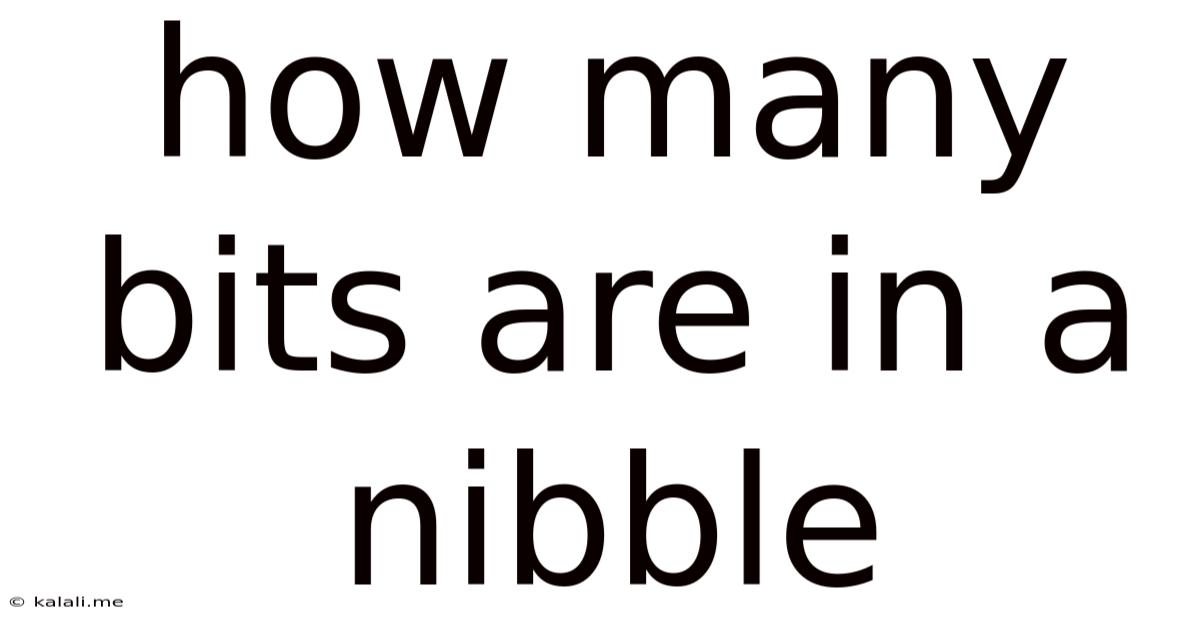How Many Bits Are In A Nibble
Kalali
Jun 11, 2025 · 2 min read

Table of Contents
How Many Bits are in a Nibble? A Deep Dive into Computer Data
Meta Description: Wondering how many bits make up a nibble? This article provides a clear and concise explanation of nibbles, their size in bits, and their role in computer data representation. Learn about bytes, words, and other data units too!
In the digital world, understanding the fundamental units of data is crucial. While terms like "byte" and "kilobyte" are relatively common, the less frequently discussed "nibble" can be a source of confusion. This article aims to clarify exactly how many bits are in a nibble, and delve a little deeper into the world of computer data units.
What is a Nibble?
A nibble, sometimes written as nybble, is a unit of data comprising four bits. Think of it as half a byte. Since a byte consists of eight bits, a nibble is precisely half that size. This seemingly small unit plays a significant role in various computer processes and data structures.
Why Nibbles? Practical Applications
While not as prominent as bytes, nibbles offer advantages in specific scenarios:
-
Hexadecimal Representation: Nibbles are perfectly suited for representing hexadecimal (base-16) numbers. Each nibble can represent a single hexadecimal digit (0-9 and A-F). This makes them useful for displaying memory addresses and data values in a more human-readable format than binary.
-
Data Compression (in some cases): In certain data compression algorithms, nibbles can be efficiently packed and manipulated. For instance, if your data naturally aligns with four-bit chunks, utilizing nibbles could lead to smaller file sizes.
-
Specific Hardware Architectures: Some older or specialized computer architectures might utilize nibble-oriented operations for specific tasks, optimizing performance in niche applications.
Bits, Bytes, Words, and More: Understanding Data Units
Let's look at the bigger picture of data units and their relationships:
-
Bit (Binary Digit): The most fundamental unit of data, representing either a 0 or a 1.
-
Nibble (4 bits): Half a byte, often used in hexadecimal representation.
-
Byte (8 bits): A fundamental unit used to represent characters, small integers, and other data types.
-
Word: The size of a word is architecture-dependent. It can be 16 bits, 32 bits, or 64 bits, representing the amount of data a processor can process in a single operation. This is why you'll sometimes see processors referred to as "32-bit" or "64-bit" processors.
-
Larger Units: Beyond words, we have kilobytes (KB), megabytes (MB), gigabytes (GB), terabytes (TB), and so on, each representing successively larger amounts of data.
In Conclusion
To reiterate, a nibble is a concise unit of data consisting of precisely four bits. While it might not be as commonly discussed as bytes or kilobytes, understanding nibbles provides a more complete picture of how data is structured and manipulated within computer systems. Its role in hexadecimal representation and potential efficiency gains in specific data handling situations make it a significant, albeit often overlooked, component of computer science.
Latest Posts
Latest Posts
-
What Year Would I Be Born If I Was 21
Jul 01, 2025
-
How Many Minutes Are In 40 Hours
Jul 01, 2025
-
How Many Cups Are In 16 Oz Of Sour Cream
Jul 01, 2025
-
How Many Quarters Are In 20 Dollars
Jul 01, 2025
-
How Many 1 3 Cups Equal A Cup
Jul 01, 2025
Related Post
Thank you for visiting our website which covers about How Many Bits Are In A Nibble . We hope the information provided has been useful to you. Feel free to contact us if you have any questions or need further assistance. See you next time and don't miss to bookmark.